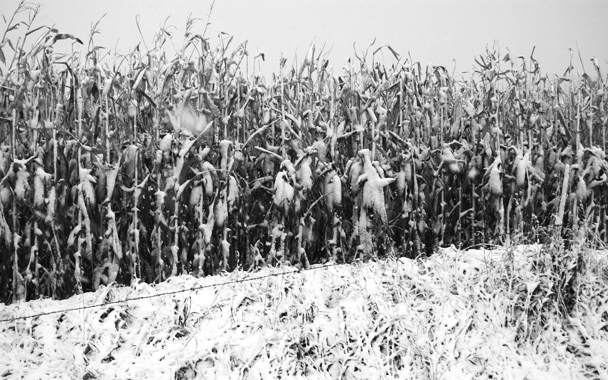The Great Cornstalk Blizzard of ’08: It happened October 27. Charlie Johnson was driving home from a wedding in Minnesota. “The wind was blowing sixty miles an hour, and field residue from the harvest started flying,” he says. “I had to pull off the road. It was a ‘white out’ ... not from blowing snow, but from blowing cornstalks.” It is a small reality that goes barely noticed, but the farm towns of South Dakota experienced more days of hurricane force winds this summer than the Texas coast.
Last Wednesday, Johnson was grouchy and was trying to push his way through a bad case of cabin fever. “I haven’t seen the sun in two weeks. Luckily we missed the worst of the blizzard, only got three or four inches of snow. But there hasn’t been a combine move in this country since last Thursday.”
“The sun came out today,” Scott Christenson reported on Thursday morning. “We didn’t know what it was. Nobody has been in the fields for a week. Maybe today we’ll get something done.”
Dale Hargens got in two days of harvest last week, and worked until 11 o’clock Thursday night. It’s the heart of the corn harvest, and nothing is moving. Hurry up and wait.
Both Hargens and Johnson have memories of harvesting corn in the dead of winter, as late as January, and friends of Johnson’s in North Dakota are already getting close to hanging it up and waiting until spring. “They can’t harvest with snow on the corn, and if it gets warm enough to melt the snow, then the ground thaws and won’t hold a combine,” explains Johnson. “They’re just trapped.”
The potential for a late-winter or spring harvest puts a focus on the volatile economics of corn production. If the crops are left to sit through the winter, wildlife begins to encroach, snowstorms batter the edges of the fields, stalks collapse. “It can potentially have a serious effect on yields,” says Hargens. “But you can’t just go to the crop insurance adjuster and ask for a check. You’ve got to make an effort to harvest the crop.” In recent years, politicians have begun to declare “emergencies” as a way to pay farmers for losses from natural disaster; it’s hard, though, to justify the call for the onset of winter.
But the inability to get a corn crop out of the field is much more than an inconvenience. Farmers are beginning to worry that the long-term consequences of their predicament could lead to a genuine disaster.
The Wall Street credit crash has finally hit South Dakota farm county, and South Dakota farmers are caught between cascading prices and the slow harvest. One of the nation’s largest ethanol manufacturers, VeraSun, based in Sioux Falls, declared bankruptcy last week. None of our four farmers has a contract with VeraSun, but Dale Hargens and Scott and Roger Christenson are watching the fate of the company with eagle eyes. They have contracts with ethanol plants in Redfield and Groton. Both plants are financially stable, perhaps because they are locally owned and small scale.
The VeraSun situation is playing out in a way that, once again, puts farmers at the bottom of the heap. For months, the company entered into contracts with farmers to buy corn as high as $6.80 a bushel. Oil prices were high. Producers simply expected to pass the costs on with the high price of gasoline. Besides, ethanol mandates in the Farm Bill and the Energy Bill promised to expand ethanol production into the distant future. Farmers read the signals from Washington, D.C., and Wall Street and expanded corn production to meet opportunity. But no one truly believed that companies could make money by manufacturing ethanol from $7 corn. Nonetheless, with their contracts in hand, farmers started spending money, expanding their own credit lines at local banks and investing in expensive inputs of fertilizer, herbicides, and pesticides; new machinery and storage facilities; and more land.
When VeraSun declared bankruptcy, farmers took the first hit, and the Iowa State University Extension Service encouraged them to immediately hire attorneys for the rocky road ahead. Farmers who had delivered on their contracts before October 11 didn’t get paid at all, and were moved to the bottom of the list for unspecified payments at some time in the future. Farmers who delivered all or part of their contracts between October 11 and 31 were paid full price for their corn, but only if they agreed to cancel their contracts and accept market prices for all future deliveries.
Go ahead, crunch the numbers, just like 1,000 farmers are doing. This week’s market price for corn on the Chicago Board of Trade is $3.70. For a farmer who contracted his crop last June for $6.80, that’s a $3.20 hit on every bushel. If he was producing 150 bushels an acre on a 1,000-acre cornfield, that’s a loss of $480,000 from June to November.
Dale Hargens is resolute. “You gotta have strong nerves to be in this business,” he says. Scott Christenson is more cynical. “All summer long everyone was complaining about the high price of food. Now that oil is coming down, and the price paid to farmers is coming down, has anyone seen food prices come down? I’m waiting to see that.”


